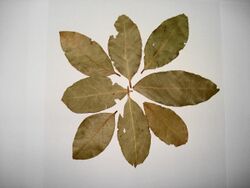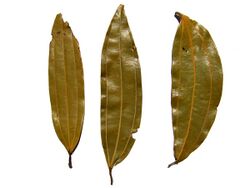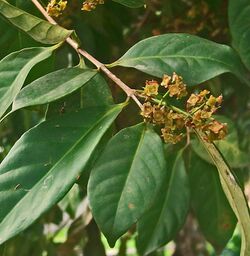Biology:Bay leaf
The bay leaf is an aromatic leaf commonly used as a herb in cooking. It can be used whole, either dried or fresh, in which case it is removed from the dish before consumption, or less commonly used in ground form. The flavor that a bay leaf imparts to a dish has not been universally agreed upon, but most agree it is a subtle addition.[1]
Bay leaves come from various plants and are used for their distinctive flavor and fragrance. The most common source is the bay laurel (Laurus nobilis). Other types include California bay laurel, Indian bay leaf, West Indian bay laurel, and Mexican bay laurel. Bay leaves contain essential oils, such as eucalyptol, terpenes, and methyleugenol, which contribute to their taste and aroma.
Bay leaves are used in various cuisines around the world, including Indian, Filipino, European, and Caribbean. They are typically used in soups, stews, meat, seafood, and vegetable dishes. The leaves should be removed from the cooked food before eating as they can be abrasive in the digestive tract.
Bay leaves are used as an insect repellent in pantries and as an active ingredient in killing jars for entomology. In Eastern Orthodoxy liturgy, they are used to symbolize Jesus' destruction of Hades and freeing of the dead.
While some visually similar plants have poisonous leaves, bay leaves are not toxic and can be eaten without harm. However, they remain stiff even after cooking and may pose a choking hazard or cause harm to the digestive tract if swallowed whole or in large pieces. Canadian food and drug regulations set specific standards for bay leaves, including limits on ash content, moisture levels, and essential oil content.
Sources
Bay leaves come from several plants, such as:
- Bay laurel (Laurus nobilis, Lauraceae). Fresh or dried bay leaves are used in cooking for their distinctive flavour and fragrance. The leaves should be removed from the cooked food before eating (see safety section below). The leaves are often used to flavour soups, stews, braises and pâtés in many countries. The fresh leaves are very mild and do not develop their full flavour until several weeks after picking and drying.[2]
- California bay leaf. The leaf of the California bay tree (Umbellularia californica, Lauraceae), also known as California laurel, Oregon myrtle, and pepperwood, is similar to the Mediterranean bay laurel but contains the toxin umbellulone, which can cause methemoglobinemia.[citation needed]
- Indian bay leaf or malabathrum (Cinnamomum tamala, Lauraceae) differs from bay laurel leaves, which are shorter and light- to medium-green in colour, with one large vein down the length of the leaf. Indian bay leaves are about twice as long and wider, usually olive green in colour, and have three veins running the length of the leaf. Culinarily, Indian bay leaves are quite different, having a fragrance and taste similar to cinnamon (cassia) bark, but milder.
- Indonesian bay leaf or Indonesian laurel (salam leaf, Syzygium polyanthum, Myrtaceae) is not commonly found outside Indonesia; this herb is applied to meat and, less often, to rice and to vegetables.[3]
- West Indian bay leaf, the leaf of the West Indian bay tree (Pimenta racemosa, Myrtaceae) is used culinarily (especially in Caribbean cuisine) and to produce the cologne called bay rum.[citation needed]
- Mexican bay leaf (Litsea glaucescens, Lauraceae).[citation needed]
Chemical constituents
The leaves of the European / Mediterranean plant Laurus nobilis contain about 1.3% essential oils (ol. lauri folii), consisting of 45% eucalyptol, 12% other terpenes, 8-12% terpinyl acetate, 3–4% sesquiterpenes, 3% methyleugenol, and other α- and β-pinenes, phellandrene, linalool, geraniol, terpineol, and also contain lauric acid.[citation needed]
Taste and aroma
If eaten whole, Laurus nobilis bay leaves are pungent and have a sharp, bitter taste. As with many spices and flavourings, the fragrance of the bay leaf is more noticeable than its taste. When the leaf is dried, the aroma is herbal, slightly floral, and somewhat similar to oregano and thyme. Myrcene, a component of many essential oils used in perfumery, can be extracted from this bay leaf. They also contain eugenol.[4]
Uses
In Indian cuisine, bay laurel leaves are sometimes used in place of Indian bay leaf, although they have a different flavour. They are most often used in rice dishes like biryani and as an ingredient in garam masala. Bay leaves are called tezpattā (तेज़पत्ता, in Hindi), Tejpātā (তেজপাতা) in Bengali, তেজ পাত in Assamese and usually rendered into English as Tej Patta.[citation needed]
In the Philippines, dried bay laurel leaves are used in several Filipino dishes, such as menudo, beef pares, and adobo.[citation needed]
Bay leaves were used for flavouring by the ancient Greeks.[5] They are a fixture in the cooking of many European cuisines (particularly those of the Mediterranean), as well as in the Americas. They are used in soups, stews, brines, meat, seafood, vegetable dishes, and sauces. The leaves also flavour many classic French and Italian dishes. The leaves are most often used whole (sometimes in a bouquet garni) and removed before serving (they can be abrasive in the digestive tract). Thai and Laotian cuisine employs bay leaf (Thai: ใบกระวาน, bai kra wān) in a few Arab-influenced dishes, notably massaman curry.[6]
Bay leaves can also be crushed or ground before cooking. Crushed bay leaves impart more fragrance than whole leaves, but are more difficult to remove and thus they are often used in a muslin bag or tea infuser. Ground bay laurel may be substituted for whole leaves and does not need to be removed, but it is much stronger.
Bay leaves can also be used scattered in a pantry to repel meal moths,[7] flies,[8] and cockroaches.[9] Mediouni-Ben Jemaa and Tersim 2011 find the essential oil to be usable as an insect repellent.[10]:131
Bay leaves have been used in entomology as the active ingredient in killing jars. The crushed, fresh, young leaves are put into the jar under a layer of paper. The vapors they release kill insects slowly but effectively and keep the specimens relaxed and easy to mount. The leaves discourage the growth of molds. They are not effective for killing large beetles and similar specimens, but insects that have been killed in a cyanide killing jar can be transferred to a laurel jar to await mounting.[11] There is confusion in the literature about whether Laurus nobilis is a source of cyanide to any practical extent, but there is no evidence that cyanide is relevant to its value in killing jars. It certainly is rich in various essential oil components that could incapacitate insects in high concentrations; such compounds include 1,8-cineole, alpha-terpinyl acetate, and methyl eugenol.[12] It also is unclear to what extent the alleged effect of cyanide released by the crushed leaves has been mis-attributed to Laurus nobilis in confusion with the unrelated Prunus laurocerasus, the so-called cherry laurel, which certainly does contain dangerous concentrations of cyanogenic glycosides[13] together with the enzymes to generate the hydrogen cyanide from the glycocides if the leaf is physically damaged.[14]
Bay leaves are used in Eastern Orthodoxy liturgy. To mark Jesus' destruction of Hades and freeing of the dead, parishioners throw bay leaves and flowers into the air, letting them flutter to the ground. [15]
Safety
Some members of the laurel family, as well as the unrelated but visually similar mountain laurel and cherry laurel, have leaves that are poisonous to humans and livestock.[13] While these plants are not sold anywhere for culinary use, their visual similarity to bay leaves has led to the oft-repeated belief that bay leaves should be removed from food after cooking because they are poisonous. This is not true; bay leaves may be eaten without toxic effect. However, they remain unpleasantly stiff even after thorough cooking, and if swallowed whole or in large pieces they may pose a risk of harming the digestive tract or causing choking.[16] Thus, most recipes that use bay leaves will recommend their removal after the cooking process has finished.[17]
Canadian food and drug regulations
The Canadian government requires that the bay leaves contain no more than 4.5% total ash material, with a maximum of 0.5% of which is insoluble in hydrochloric acid. To be considered dried, they must contain 7% moisture or less. The oil content cannot be less than 1 milliliter per 100 grams of the spice.[18]
References
- ↑ "What Are Bay Leaves?" (in en). https://www.thespruceeats.com/what-is-a-bay-leaf-995576.
- ↑ "Spice Trade: Bay Leaf". http://www.spice-trade.com/bay-leaf.html.
- ↑ "Spice Pages: Indonesian Bay-Leaf". http://gernot-katzers-spice-pages.com/engl/Euge_pol.html.
- ↑ "Encyclopedia of Spices: Bay Leaf". http://www.theepicentre.com/Spices/bay.html.
- ↑ "Ancient Egyptian Plants: Trees" www.reshafim.org.il Retrieved October 29, 2013
- ↑ Tan, Hugh T. W. (2005). Herbs & Spices of Thailand. Marshall Cavendish. p. 71.
- ↑ "How to Repel Grain Moths with Bay Leaves". http://www.care2.com/greenliving/repel-grain-moths-with-bay-leaves.html.
- ↑ Palacios, S; Bertoni, A; Rossi, Y; Santander, R; Urzua, A (2009). "Efficacy of Essential Oils from Edible Plants as Insecticides Against the House Fly, Musca domestica L.". Molecules 14 (5): 1938–1947. doi:10.3390/molecules14051938. PMID 19471213.
- ↑ Hedin, Paul Arthur; Hedin, Paul A. (1991). Naturally Occurring Pest Bioregulators. ACS Symposium Series. 449. doi:10.1021/bk-1991-0449. ISBN 978-0-8412-1897-0. https://archive.org/details/naturallyoccurri00paul.
- ↑ Moharramipour, Saeid; Negahban, Maryam (2014). "Plant Essential Oils and Pest Management". in Sahayaraj, K.. Basic and Applied Aspects of Biopesticides. New Delhi: Springer India. pp. 129–153. ISBN 978-81-322-1876-0. OCLC 884262582. ISBN:978-81-322-1877-7.
- ↑ Smart, John (1963). British Museum (Natural History) Instructions for Collectors NO. 4A. Insects. London: Trustees of the British Museum.
- ↑ Marzouki, H; Piras, A; Salah, KB; Medini, H; Pivetta, T; Bouzid, S; Marongiu, B; Falconieri, D (2009). "Essential oil composition and variability of Laurus nobilis L. growing in Tunisia, comparison and chemometric investigation of different plant organs". Nat Prod Res 23 (4): 343–54. doi:10.1080/14786410802076200. PMID 19296375.
- ↑ 13.0 13.1 van Wyk, Ben-Erik; van Heerden, Fanie; van Oudtshoorn, Bosch (2002). Poisonous Plants of South Africa. Pretoria: Briza. ISBN 978-1875093304.
- ↑ Dietmar Schomburg; Margit Salzmann (11 November 2013). Enzyme Handbook: Volume 1: Class 4: Lyases. Springer Science & Business Media. pp. 270–. ISBN 978-3-642-86605-0. https://books.google.com/books?id=8uf7CAAAQBAJ&pg=PT270.
- ↑ "ORTHODOX BELIEF: JESUS WENT TO HELL" (in en). https://www.chicagotribune.com/news/ct-xpm-1997-04-28-9704280142-story.html.
- ↑ Benwick, Bonnie S. (30 September 2014). "Bay leaf: Should it stay or should it go?". Washington Post. https://www.washingtonpost.com/lifestyle/food/bay-leaf-should-it-stay-or-should-it-go/2014/09/30/131eb444-429e-11e4-9a15-137aa0153527_story.html.
- ↑ "Straight Dope: Are Bay Leaves Poisonous?". 2007-02-23. http://www.straightdope.com/columns/read/2695/what-is-the-origin-of-the-song-theres-a-place-in-france-where-the-naked-ladies-dance.
- ↑ "Consolidated federal laws of Canada, Food and Drug Regulations". 2019-06-03. https://laws.justice.gc.ca/eng/regulations/C.R.C.,_c._870/page-37.html#h-570402.
 |




